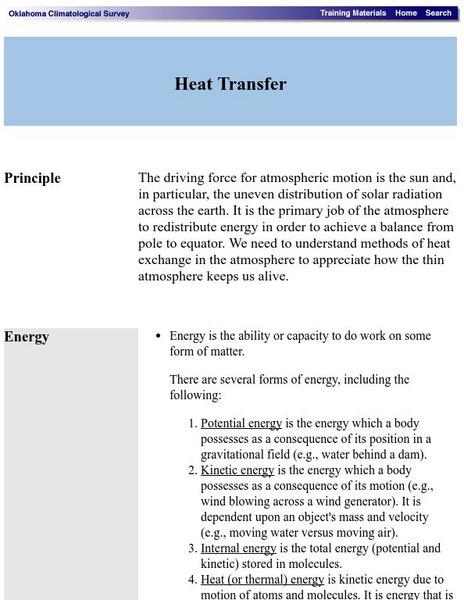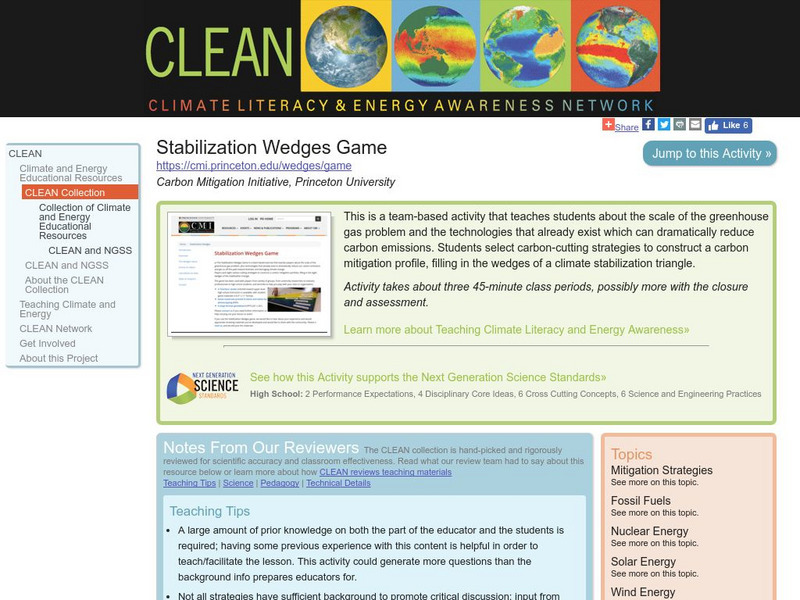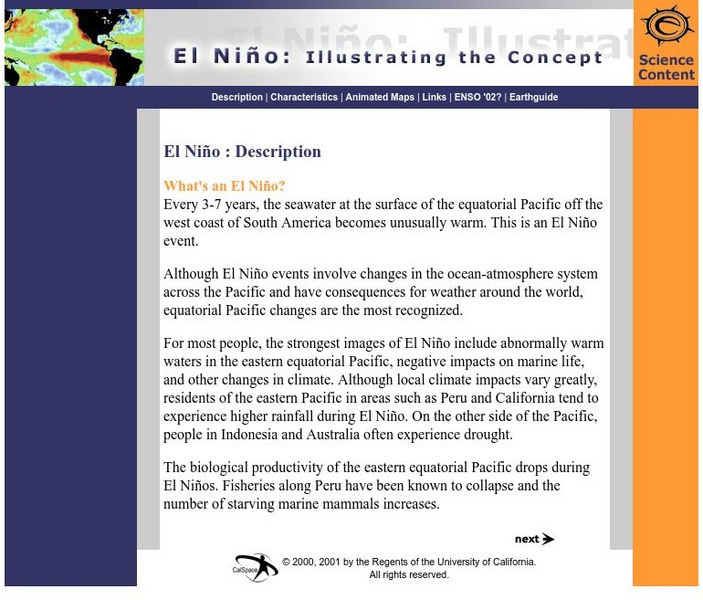Hi, what do you want to do?
University Corporation for Atmospheric Research
Ucar: What Is Weather?
Weather is the mix of events that happen each day in our atmosphere. Learn how weather events are controlled by air pressure, how Meteorologists predict the weather and the difference between weather and climate.
Annenberg Foundation
Annenberg Learner: What Forces Affect Our Weather?
A great starting point for learning about the weather and for finding help starting your own investigation of what affects the weather. Site is organized into the following sections: "The Atmosphere," "The Water Cycle," "Powerful...
PBS
Pbs Learning Media: What Causes the Gulf Stream?
This video segment adapted from NOVA uses satellite imagery to illustrate the Gulf Stream's path and animations to explain how atmospheric phenomena cause it to move. [1:51]
John Wiley & Sons
Wiley: Environment: Chapter 21: The Atmosphere, Climate and Global Warming
A companion site to the textbook, Earth as a Living Planet. This chapter discusses global warming and how to deal with it.
NASA
Nasa: Climate Kids: Gallery of Air
A photo collection containing images of air pollution and other related air concerns.
Other
Creating Minds: Creating a Creative Climate
Written from a business perspective, this sites ideas about creating a creative atmosphere can easily be adapted to any classroom.
Science Education Resource Center at Carleton College
Serc: Lab 1: Think Globally: Act Locally
A lab experiment in a series of experiments that explores Earth Science Systems. This lab introduces students to the parts of the Earth system: the atmosphere, hydrosphere, biosphere, and pedosphere. As the students learn about the...
University Corporation for Atmospheric Research
Ucar: Fact Sheet for El Nino
This site from the Univ. Corp. for Atmospheric Research provides detailed information on El Nino and its effects on the trade winds is offered at this site, with satellite photos.
Climate Literacy
Clean: Understanding Ocean Acidification
The following is a series of 5 activities regarding ocean acidifcation Young scholars will learn about rising Carbon Dioxide in the atmosphere, climate change, ocean reefs, marine calcifers and ocean pH.
NASA
Nasa Earth Observatory: Should We Talk About the Weather?
Discover how scientists use the BOREAS to gather data such as heat, carbon dioxide, water vapor, and more to see what role these levels have on climate changes.
Science Education Resource Center at Carleton College
Serc: Carbon Temperature Model
With this carbon/temperature interactive model, students investigate the role of atmospheric carbon in the greenhouse effect using a relationship between atmospheric carbon dioxide and global temperature.
Oklahoma Mesonet
Oklahoma Climatological Survey: Heat Transfer
A discussion from the Oklahoma Climatological Survey of the thermal factors effecting the movement of air masses in the atmosphere. Numerous topics such as methods of heat transfer, latent heat, phase changes (including sublimation and...
Thinkport Education
Thinkport: Made Clear: How Do Scientists Collect Data?
Find out how scientists continually collect information about the Earth and its atmosphere.
Climate Literacy
Clean: Stabilization Wedges Game
A team-based exercise that teaches players about the scope of the greenhouse gas problem, plus technologies that already exist to dramatically reduce our carbon emissions and help steer Earth away from climate change.
Annenberg Foundation
Annenberg Learner: The Habitable Planet: Energy Lab
Try and meet global energy demands by using alternative energy sources while keeping the carbon levels in the atmosphere down to acceptable levels. Simulator includes a data table available for download for student records.
NASA
Nasa: Global Wind Patterns
This site from NASA lists and defines global wind patterns. It features a graphic of these patterns and a self-test with answers.
Climate Literacy
Clean: Greenhouse Gas in a Bottle Demonstration
A simple demonstration that is quick and easy to setup and provides dramatic evidence of the effect on temperature of an atmosphere with increased carbon dioxide. [4 min]
Other
Canterbury Environmental Education Centre: Weather Explorer
A look at the weather, how it is measured, and how it is caused. Learn what weather is like all over the world, how global warming is affecting our planet, and how "extreme" conditions like hurricanes, tornadoes, floods, and drought...
University of California
Earthguide: El Nino: Illustrating the Concept
Do you know what happens during a typical El Nino? This overview provides a description, characteristics, and animated maps showing sea surface temperature changes during past El Nino events.
US Environmental Protection Agency
Epa: Global Warming Wheel Card [Pdf]
Students construct a Global Warming Wheel Card, a hand-held tool that they can use to estimate their household's emissions of carbon dioxide and learn how they can reduce them.
Frostburg State University
General Chemistry Online: Environmental Chemistry Faq
Find answers to common questions asked about environmental chemistry. Environmental toxins and recycling are among the topics covered in the FAQ.
Science Education Resource Center at Carleton College
Serc: From Grid to Home
Students analyze energy use, cost, and source patterns from household to regional scales and relate these patterns to CO2 emissions.
CK-12 Foundation
Ck 12: Earth Science for Middle School
This digital textbook covers core earth science concepts and includes interactive features, real-world examples, videos, and study guides.
BioEd Online
Bio Ed Online: Greenhouse S'mores
Students learn about climate change as they investigate how different materials are affected by a greenhouse effect. The lesson and accompanying PowerPoint can both be downloaded.


















![Epa: Global Warming Wheel Card [Pdf] Activity Epa: Global Warming Wheel Card [Pdf] Activity](https://content.lessonplanet.com/knovation/original/84558-16fbabe6543bc08a2c6e61c7cc193c00.jpg?1661812588)


